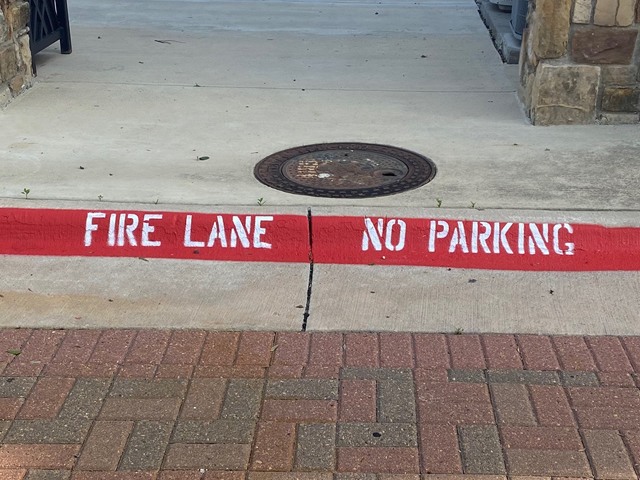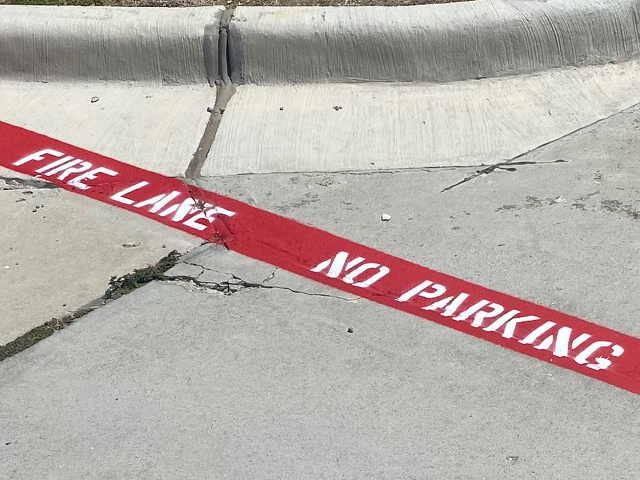What are the requirements for a fire lane in Texas?
Fire lanes in Texas are designed to provide clear access for emergency vehicles and must meet specific requirements set by local municipalities and fire codes. These requirements include minimum dimensions, signage, striping, and ensuring the lane remains clear at all times.
Understanding Fire Lane Dimensions and Clearance
A fire lane must maintain specific dimensions to allow large emergency vehicles to pass through without obstruction. According to most local fire codes in Texas, fire lanes must be at least 20 feet wide. This ensures enough room for fire trucks and ambulances to navigate the area quickly in case of an emergency. Additionally, vertical clearance is important, often requiring at least 14 feet of overhead clearance to avoid blocking emergency vehicle access with trees or building overhangs.
It’s important for business owners to consult their local fire marshal, as some municipalities may have stricter or additional requirements regarding fire lane width and clearance.


Proper Fire Lane Signage
Fire lane signage is crucial to enforce the “no parking” rule and ensure these lanes remain clear for emergency use. In Texas, fire lane signs must be clearly visible and follow specific guidelines outlined in the local fire codes. These signs typically include the wording “Fire Lane – No Parking” in clear, large font.
The placement of these signs is also regulated. They must be installed along the fire lane at regular intervals, ensuring that no part of the lane is left without clear signage. The signs must be visible from all angles, especially from the driver’s point of view. Some municipalities may specify the distance between signs, which often ranges from 25 to 50 feet apart.
Fire Lane Striping Requirements
In addition to signage, fire lanes must be marked with proper striping. This usually involves red-painted curbs or pavement, with white or yellow lettering that clearly states “Fire Lane – No Parking.” The striping should be bright, reflective, and visible both day and night.
The standard size for the lettering on a fire lane is at least four inches in height, though local regulations may require larger letters for added visibility. The color red is generally required, as it symbolizes an emergency area and is easily distinguishable from other parking spaces.
Regular maintenance of the striping is important. Over time, paint can fade due to weather conditions and traffic, so repainting is essential to ensure that the fire lane remains compliant with regulations.
Maintaining a Clear Fire Lane
One of the most important aspects of fire lane requirements is keeping the lane clear at all times. Vehicles parked in a fire lane can obstruct emergency responders, leading to delays during critical moments. In Texas, parking in a fire lane is illegal, and violators may face fines or towing.
Business owners should take proactive steps to enforce fire lane rules. This might include regularly checking that vehicles are not parked in these areas and having clear policies in place for employees and visitors. Working with a parking lot striping company that understands fire lane regulations is essential to ensure compliance with local codes.
Do Local Requirements Vary for Fire Lanes in Texas?
Yes, local municipalities in Texas may have additional or stricter requirements for fire lanes. While state guidelines provide a general framework, it is essential to check with local fire marshals to ensure that your business complies with all regulations. Some cities may require more frequent fire lane inspections, while others may have additional rules regarding fire lane width, striping materials, or signage.
For example, cities like Dallas, Houston, or Austin may have slight variations in how fire lanes should be marked or maintained. If you’re unsure about local regulations, contacting the city’s fire department or a fire marshal is the best way to ensure compliance.
What Happens if Fire Lane Requirements Are Not Met?
Failing to meet fire lane requirements can lead to severe consequences for business owners. Not only can it result in fines or legal action, but it could also endanger lives in an emergency. Fire marshals regularly inspect fire lanes, and violations may result in costly penalties.
In some cases, non-compliance could even lead to delays in securing occupancy permits or renewing business licenses. For these reasons, it is essential to work with a qualified parking lot striping contractor who can ensure that your fire lanes are up to code and properly maintained.
Ensuring Compliance with Fire Lane Requirements in Texas
Meeting fire lane requirements in Texas involves adhering to specific rules about lane dimensions, signage, striping, and keeping the lane clear. Business owners should be aware of both state and local regulations to avoid penalties and ensure the safety of their property. Regular maintenance and working with experienced parking lot striping professionals will help keep fire lanes compliant and visible for emergency responders.
Ensuring that your fire lane is properly marked and maintained not only helps you meet legal requirements but also ensures the safety of your employees, customers, and visitors.

